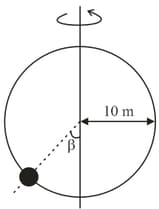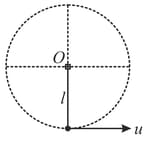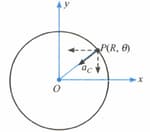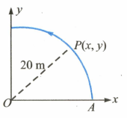A small bead can slide without friction on a circular hoop that is in a vertical plane and has a radius of . The hoop rotates at a constant rate about a vertical diameter. Find the height of the bead (in ) above the bottommost point if the angular velocity of rotation is .


Important Questions on Circular Motion
A toy car is moving anticlockwise on a closed track whose curved portions are semicircles of radius . The adjacent graph describes the variation of speed of the car with distance moved by it (starting from point ). Find the time required for the car to complete one lap in second, (take )

Small parts each of mass on a conveyer belt moving with constant velocity are allowed to drop into a bin. Radius of circular portion is . The static coefficient of friction between the parts and belt is . If the parts start sliding on the belt at the angle . Find the velocity (in ) of conveyer belt.






A ball is given a velocity of as shown. If the ratio of centripetal acceleration to tangential acceleration is at the point where the ball leaves circular path then write the value of . [Neglect the size of ball]

A bob of mass is connected to a thread of length and projected horizontally with speed of so that it completes vertical circle. What is the difference between maximum tension and minimum tension (in )?

For a particle in uniform circular motion, the acceleration at a point on the circle of radius is (here, is measured from the -axis),

A point moves in counter-clockwise direction on a circular path as shown in the figure. The movement of is such that it sweeps out a length , where is in metres and is in seconds. The radius of the path is . The acceleration of when is nearly,

